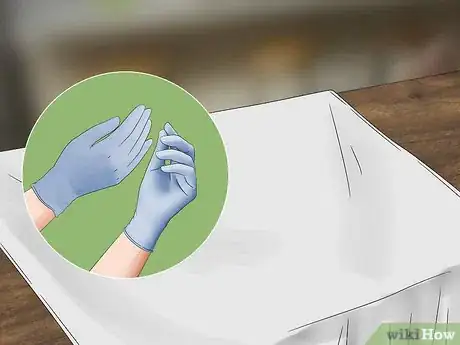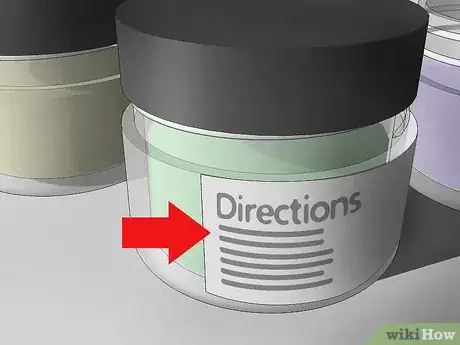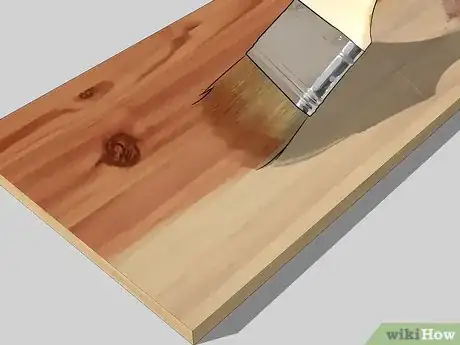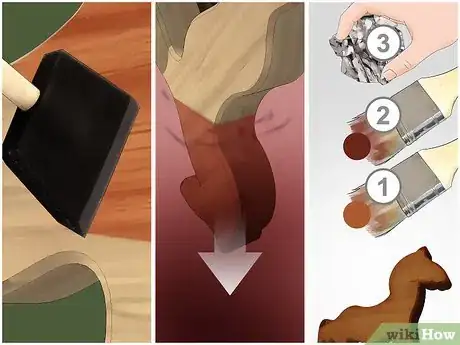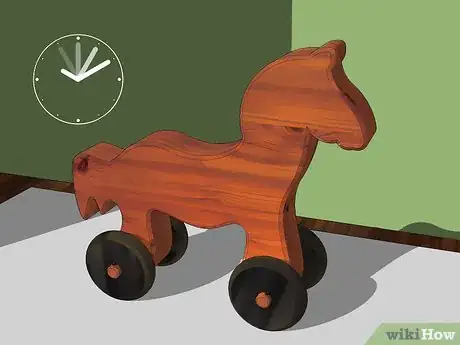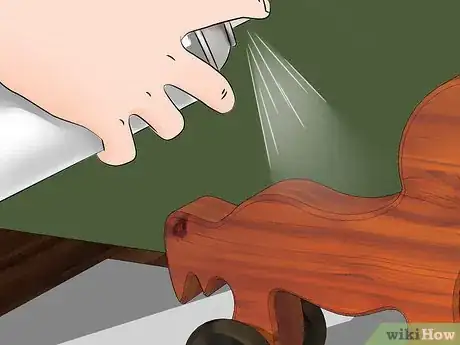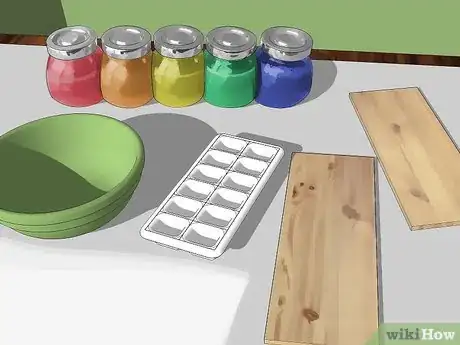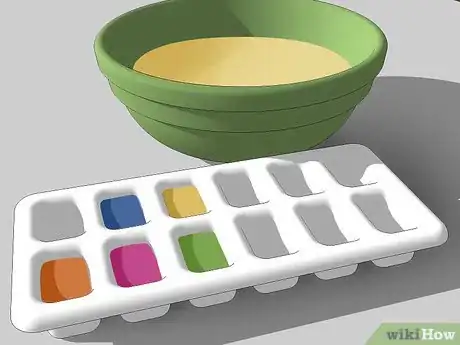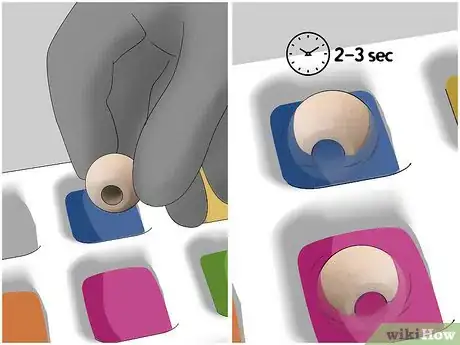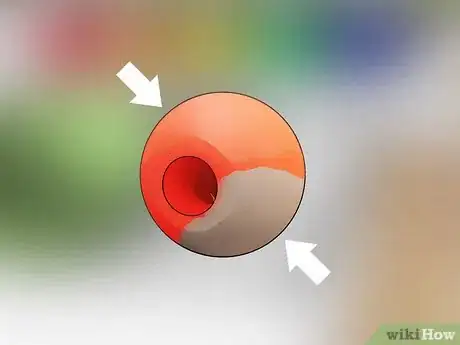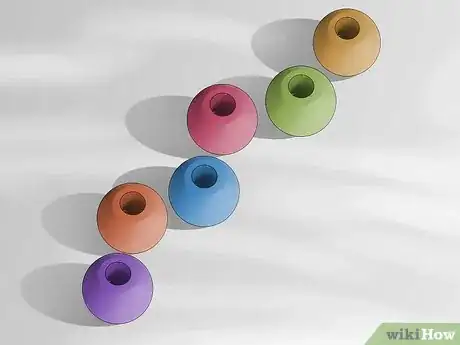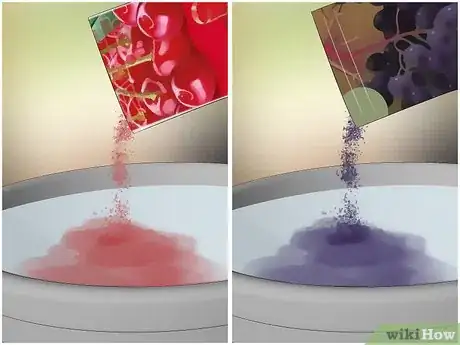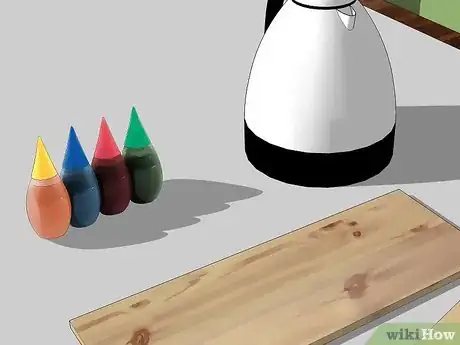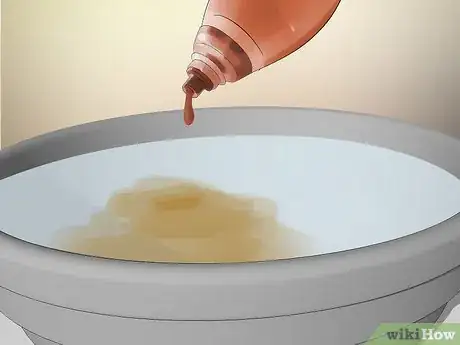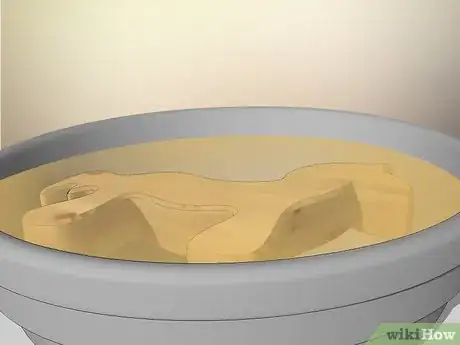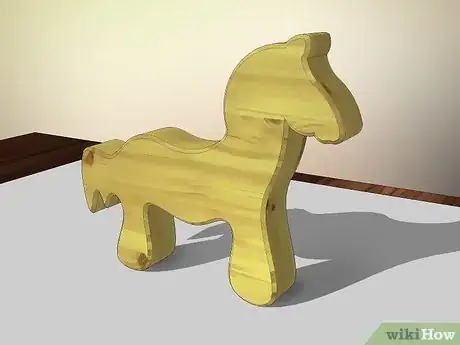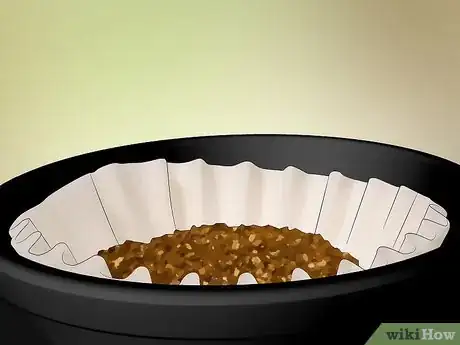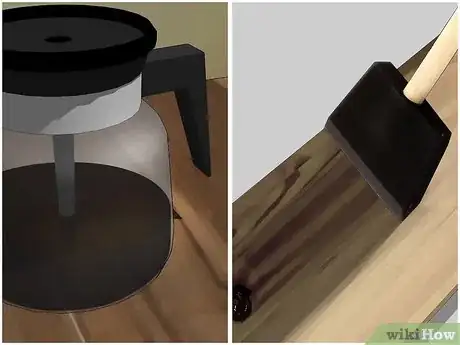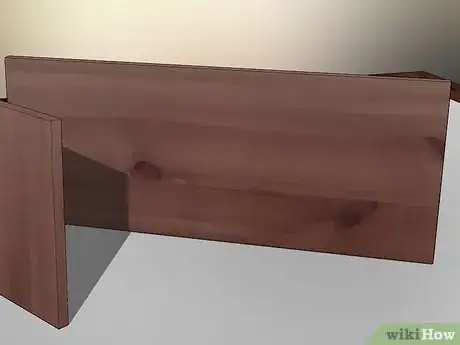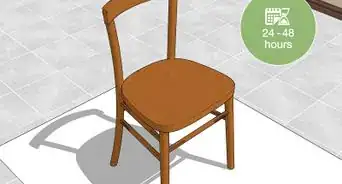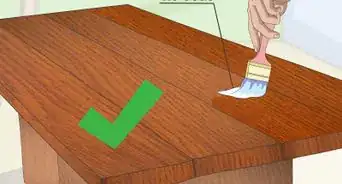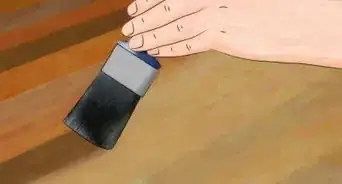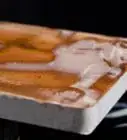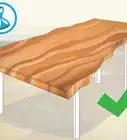wikiHow is a “wiki,” similar to Wikipedia, which means that many of our articles are co-written by multiple authors. To create this article, 12 people, some anonymous, worked to edit and improve it over time.
This article has been viewed 143,254 times.
Learn more...
Dyeing wood can be useful for craft projects, building work or other reasons. Dyeing wood can be done in a number of ways, often with materials that you may have lying around the house. If you have an afternoon free, you can turn those blocks, beads, or that table into an eye-popping piece of art.
Steps
Using Powder Dye
-
1Cover your work surface. It’s best to cover wherever you’re working with a plastic cloth – newspapers may soak through. Cover your hands, too, with rubber gloves; if you don’t, you’ll end up with fun-colored fingers by the end of the project. To get started, you'll need:
- One container for every color of dye
- Paintbrushes
- Hot water
- Polyurethane spray (optional)
-
2Make sure your wood is ready to be dyed. If you’re working with a piece of scrap wood, it may have to be sanded and wiped clean. If it has a varnish, you’ll need to strip it and sand it until smooth.
- Wood bought from craft supply stores (blocks or beads, for example) is ready to go. If you haven't yet purchased wood and are looking to do so from a home improvement store, ask if they'll sand it for you.
Advertisement -
3Shake all the dye bottles and pour them each into a container. Mix the dye according to the package instructions – you’ll probably need ½ cup liquid dye or 1 box of powder dye with 2 cups of very hot water. Use a glass or ceramic bowl to avoid reactions with the dye colors in the microwave and stir well.
- If you’re using the immersion method, you’ll need the same amount of dye with 2 ‘’quarts’’ of water (depending on the size of your product).
- There are many different types of wood dyes out there, and some are just wood stains. Rit dye, like the kind you'd buy for fabric, makes a great, easy-to-use, cheap dye for woods that's widely available in craft supply stores.
-
4Test a piece of scrap wood. Dip a piece of scrap wood (or use an area of the wood you’re using that can’t be seen) into the bowl of dye. Give it a minute or two to dry as it’s darker when wet. If you don’t like it, add more dye or more water as needed.
- This won't give you the exact final hue, but it'll be close. It'll also show you how the dye spreads and how you have to apply the dye to get the look you want.
-
5Dye your wood. There are a number of methods you can use:
- Brush-on method. Dip a foam or bristle brush or old cloth in the dye and spread it evenly over your wood surface. If dye drops splash onto your wood, you can get rid of them by sanding the wood immediately. Let it dry and reapply as necessary.
- Immersion method. Place the wood gently into the prepared dye. Leave in for as long as it takes to achieve the desired color (likely 10-20 minutes. Keep in mind that the colors dry much lighter than they appear when wet.
- Weather-beaten look. Chose two dye colors to apply one after the other. Start with the lighter shade and let dry. Then apply the darker shade and let dry. Once it is dry, lightly sand the entire piece, exposing the lighter shade underneath. Repeat applications as necessary. Rub with sandpaper or steel wool to create shaded areas when finished.
-
6Allow it to completely dry. Remove the wood from the dye when you're satisfied it is ready. Lay it out to dry on paper towels or some other suitable surface that it won’t stick to. Then, leave it overnight for best results.
-
7If desired, spray with polyurethane to preserve the dye color. Polyurethane can also be applied with a new bristle or foam brush. This can be useful if the wood object is to undergo wear and tear through frequent usage, such as for beads in jewelry.[1]
- Keep in mind that this method is not safe to use with baby's toys or other objects that may get placed in the mouth.
Using Liquid Watercolors
-
1Assemble everything you need. This is great as an at-home DIY project or even as a craft project with kids – liquid watercolors are non-toxic and fun and easy to use. Here’s what you’ll need:
- Pieces of wood
- Liquid watercolors
- Bowls, cups, or ice tray
- Wax paper
- Paintbrushes (optional)
-
2Pour a bit of each color you want into a cup, bowl, or ice cube tray. An ice cube tray is convenient as you can put small amounts of each color into each little container, but if you need a wider area (for dipping, etc.) you’ll be better off with a wider-brimmed bowl.
- The beauty of liquid watercolor is that it is good to go. No mixing or heating up necessary. When you pour it in, that's all you need to do. It lasts much longer than food coloring and is cheaper, too.
-
3Dip the wood in the color for about 2-3 seconds. That’s really all it takes – at least at first. Dip it in for just a few seconds and see what you think of the color. Remember: it will get lighter as it dries.
- It’s not a bad idea to dip in one side and set the wood down to dry on a side that isn’t dyed yet. Then you know whichever side it lays on won’t get tarnished or stick to the surface when laid down.
- If the color is too light, dip it in for a few seconds once more, applying another coat.
-
4Apply dye to all sides of the object. If you're worried about getting it on your fingers, put on a pair of rubber or plastic gloves. However liquid watercolors do wash off pretty easily if addressed quickly.
- Keep this in mind for your objects, too. If they get exposed to water, the dye could start coming off – at least eventually. It's important they stay dry (out of water and out of mouths).
-
5Let dry on a sheet of wax paper. Once you’re finished dyeing, set all the pieces on wax paper to dry overnight. Come back to them in the morning and see if you like the color. If not, you can always reapply.
Using Drink Powder
-
1Set up your workspace. Before doing anything with the wood, you should have a suitable place to work in, where you can make a mess and it doesn't matter. Use a table or other surface that is comfortable to work on and that you’re okay getting a splash of dye on. Cover it with a plastic cloth or some other protective surface.
- You'll probably want to put on an old t-shirt and some plastic or rubber gloves, too.
-
2Prepare the drink powder. With rubber gloves on to prevent staining your hands and fingers, add a package of drink powder to water to create a dye. Adjust your ratio of water to powder until you get the shade that you want.
- Cherry drink powder will come out red, grape will come out purple, etc. If you want a darker, deeper shade, just add less water. You can also combine colors (red and yellow make orange, for example) if the color you want is unavailable in flavor form.
- The best perk of using drink powder as your dye? It smells delicious.
-
3Paint the dye onto the wood. Using a foam brush, spread the paint everywhere on the wood, wherever you need the dye to be applied. It will soak right in and smell fruity too. Remember that it will get lighter as it dries, so wait a minute to see if you need to apply another coat or two.
- You'll probably need a couple of layers, so be patient. Be sure to coat the entirety of the wood before you move onto coating it a second time to keep the color even.
-
4Let the wood dry. Wait for 16-20 minutes after you have finished spreading the dye. This will give the dye time to soak into the wood. Then, put the drying wood in a sunny or windy place to dry quickly. When that time is up, your art is ready.
- Check the color. When the wood dries completely, see if the color is dark enough for your liking. If it isn't dark enough, dye the wood again.
Using Food Coloring
-
1Prepare a workspace. Cover the surface with paper or some other suitable material, like a plastic tablecloth, to protect the area from getting stained. You might want to wear rubber gloves, too. You'll also need:
- One container for each dye
- Warm or hot water
- Plastic bags (if immersing)
-
2Place a few drops of dye in a suitable container full of warm/hot water. The more dye that you add, the more saturated the color will be (and the less water you use, too). Light wood works the best with food coloring as it takes on color much more easily.
- Mix it up well – food coloring has a tendency to take a while to dissolve if it isn't given a push in the right direction.
- The darker (and bigger) the wood and the more water you have, the more dye you will need. Be prepared to clean out your stock in your kitchen for the craft.
-
3Place the wood in the water-dye mixture. A resealable plastic bag is ideal for immersing the wood, depending on how large the piece of wood is. If it is really large, use a plastic tub.
- You can also use a foam brush to apply the dye. This makes it easier to control and is better for smaller objects that have nooks and crannies. It does take a bit more patience, however.
-
4If immersing the entire piece, let it sit in the dye for 10 minutes or so. The longer it sits, the more saturated the color will be. Want it bright and vibrant? Leave it in, go watch an episode of your favorite TV show, and then come back and check on it.
- If you're using the brush-on method, you'll probably need at least 3 or 4 coats to get a significant color. Apply the first coat around the entire object before you move onto the 2nd to ensure an even look.
- Keep in mind that the color will lighten as it dries.
-
5When finished, let the wood dry. Use paper towels or some other surface you're okay staining. Leave at least overnight, and check in the morning. If it's gotten too light, you can simply apply another coat or two.
- If you're happy with the color, considering sealing it in by spraying the surface with a polyurethane spray. You can also take a brush to spread it on. This adds a varnish or shine to the object in addition to providing a seal against general wear and tear.
Using Coffee
-
1Brew a pot of coffee. For the record, this isn't a very strong dye and is only suitable for light colored wood, such as pine. The end result will look "weathered.” Make sure it is as strong a brew as possible; the darker the coffee, the darker the dye effect.
- Dyeing a dining room table that seats 14? You may need more than just a pot.
-
2Add the grounds back into the coffee pot. These will be used as part of the dye, making it richer and deeper – and that translates to fewer coats for you to spread.
- Before you go to dip your rag or paintbrush in the coffee, you may want to put on rubber or plastic gloves to keep coffee stains off your hands.
-
3Remove from the heat and allow to cool slightly. While the coffee is still warm (not hot), use a paintbrush or rag dipped into the coffee and apply it to the wood. Rub or paint back and forth, across the wood.
- Don't worry about the grounds; press them in if you can but just keep moving back and forth. Leave the grounds in place for darker dyeing.
-
4Allow to dry. If you're working with a smaller object, arrange on paper towels or towels to dry. Some coffee may drip down the sides, depending on your process. This is generally fine, as it will give it a perfectly-imperfect look.
-
5Add more layers until the color or effect is as you'd like it. After a few layers, the effect can be quite evident. Reheat the coffee until it's warm again to bring back its potency, and reapply.
- Remember to let it dry before you apply another layer. It will be slightly darker when wet.
- If you like the current shade, consider sealing it with polyurethane spray or a wood varnish. This will help the color last longer, give it a sheen, and protect it against the elements.
Community Q&A
-
QuestionAre there any kinds of woods colored solid threw the entire wood?
 Community AnswerDepends on the color, but there are some, for example; ebony is black, redheart is red or pink, bloodwood is red and yellowheart is yellow.
Community AnswerDepends on the color, but there are some, for example; ebony is black, redheart is red or pink, bloodwood is red and yellowheart is yellow.
Things You'll Need
Method 1:
- Work surface and covers
- Rubber gloves
- Powder dye
- Non-reactive mixing bowls
- Stirring implement
- Wood
- Drying area
Method 2:
- Workspace covers
- Rubber gloves
- Non-reactive containers
- Wood
- Liquid watercolors, colors of choice
- Paintbrush
- Wax paper
- Paper towels or drying surface
- Polyurethane spray (optional)
Method 3:
- Drink powder
- Rubber gloves
- Workspace covers
- Stirring implement
- Non-reactive containers
- Paint brush, plastic bag, or tub
Method 4:
- Food coloring
- Stirring implement
- Rubber gloves
- Non-reactive mixing bowls or containers
- Wood
- Paper towels or towels, etc., for drying
- Polyurethane spray (optional)
Method 5:
- Coffee
- Coffee pot
- Wood (light color)
- Paintbrush or clean rag
- Paper towels, towels, etc. for drying
- Rubber gloves (optional)
References
About This Article
There are a variety of ways to dye your wood for arts and crafts or home improvement. To use powder dye, mix it with hot water, then brush it onto your wood or soak your wood in it. Liquid watercolors are a great option for smaller pieces of wood. Just dip your wood into the paint so it’s fully coated and leave it to dry on a sheet of wax paper. You can also dye your wood with drink powder by mixing the powder with water and painting it onto your wood. Another easy option is food coloring. All you need to do is mix it with hot water and soak your wood in the solution for 10 minutes. For more tips, including how to dye your wood with coffee, read on!
